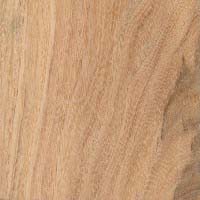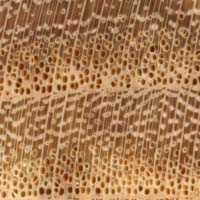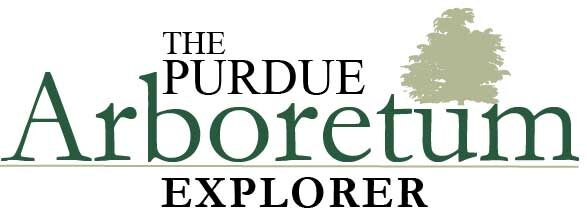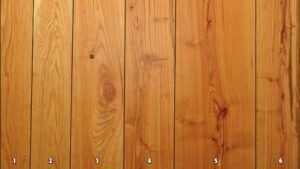Gleditsia triacantho
Summary
Beneath the thorns of wild honeylocust (Gleditsia triacanthos L.) lies a beautiful coarse-grained, pink wood much like red oak. Since sawlog quality trees are not abundant, the species is not often traded in the wholesale market, but sooner or later, every hardwood sawmill will likely produce some honeylocust lumber. For the woodworker looking for something a little different and at a reasonable price, honeylocust could be the ticket.
Board 1 shows the reddish pink color and coarse grain pattern of honeylocust. On the left edge and toward the bottom, some darkening can be seen due to the accumulation of dark substances in the vessels. Board 2 is similar to the first but shows a light yellowish colored sapwood at the top. Board 3 shows a sound and unsound knot. Boards 4, 5, and 6 are cut directly from the heart of the tree. The small dark spots are ingrown thorns. The brown streaking is decay that occurred in the living tree, and it is common for this species. The streaked areas are still firm.
History
Hard thorns of younger trees were used as nails and the wood was used to make treenails for shipbuilding.
Color & Texture
The wood is ring porous. The large earlywood pores abruptly change to small diameter thick walled cells. As a result, the wood has a grain pattern about like red oak. Some of the pores will be filled with dark inclusions, but usually not to the extent that a dark objectionable streak develops. Unfinished heartwood is pink. Sapwood is white.
Anatomical and Microscopy


Ring-porous; 3-5 rows of large to very large earlywood pores, medium to small latewood pores commonly arranged in tangential bands; tyloses absent, other reddish heartwood deposits occasionally present; growth rings distinct; medium to wide rays visible without lens, wide spacing; parenchyma banded, parenchyma vasicentric, and latewood is commonly lozenge and confluent.
Wood Properties
- Workability
- As a dense wood, it is reported to machine well
- Strength
- Comparable to Red Oak
- Steam Bending
- No information available
- Drying
- No information available
- Shrinkage
- Very Low
- Decay
- Resistant or very resistant to wood decay
Products
Used as pallets or blocking due to lack of an established market. Higher value uses are for custom furniture, cabinets, millwork, and flooring. Honeylocust is a beautiful wood that deserves more attention.

